From coastal towns built into the hills to lakeside gems hemmed in by mountains, Italy is awash with scenic beach towns that capture the spirit of summertime. Here are 30 of the most charming, ordered from north to south.
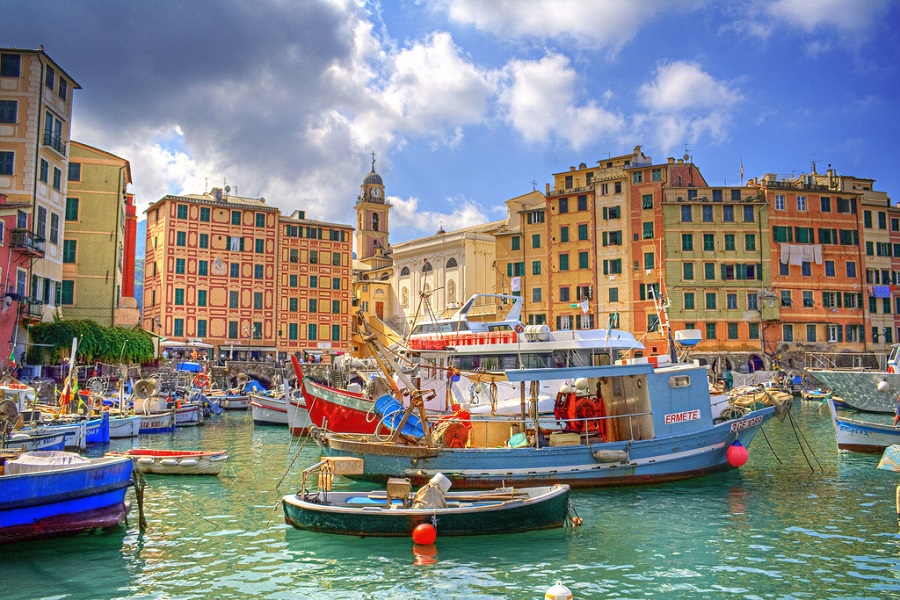
The colourful waterfront of Camogli (Photo: moon0903 via Wikimedia / CC BY-SA 2.0 )
Italy’s shorelines are consistently impressive – as are the towns that sit adjacent to them. Some 4,700 miles of coastline encircle Italy’s boot and its islands, winding across 15 of its 20 regions. Add to this a handful of lakes and it isn’t hard to see why the country is a top summer holiday destination. But there’s more to a brilliant beach town than turquoise waters and expansive sands. The best are bursting with coastal charm, gastronomic delights and a good range of accommodation. The most charming beach towns have something to say for themselves beyond a beautiful beach, be it an Aragonese castle, a cobbled Old Town or a remarkable festival.
To compile this list, we took on feedback from a variety of local specialists – bloggers, writers and photographers. To be eligible for inclusion, each town must have a population of at least one thousand and fewer than 30,000 people. We also limited entries to three per region, to ensure that the best of Italy’s historically overlooked regions could feature alongside the usual suspects. Finally, we added some ‘hidden gems’ into the mix: beach towns that allow visitors to sidestep the usual tourist traps and slip into a slower pace of life.
Orta San Giulio, Piedmont
Lesser known than other Italian lakes, Lake Orta offers equally charming scenery. Orta San Giulio is its undisputed pearl, a fully pedestrian centre of stone houses and old palaces stretched along the shore. Its captivating blend of rustic and refined elements is exemplified by the frescoed Palazzotto, the former administrative hub overlooking Piazza Motta. This porticoed square serves as the town’s parlour and the docking point for boats to and from the mystical San Giulio Inlet. The hilltop religious complex is one of nine UNESCO-listed ‘sacred mountains’, while the hamlet of Legro is known for the many murals adorning its streets.
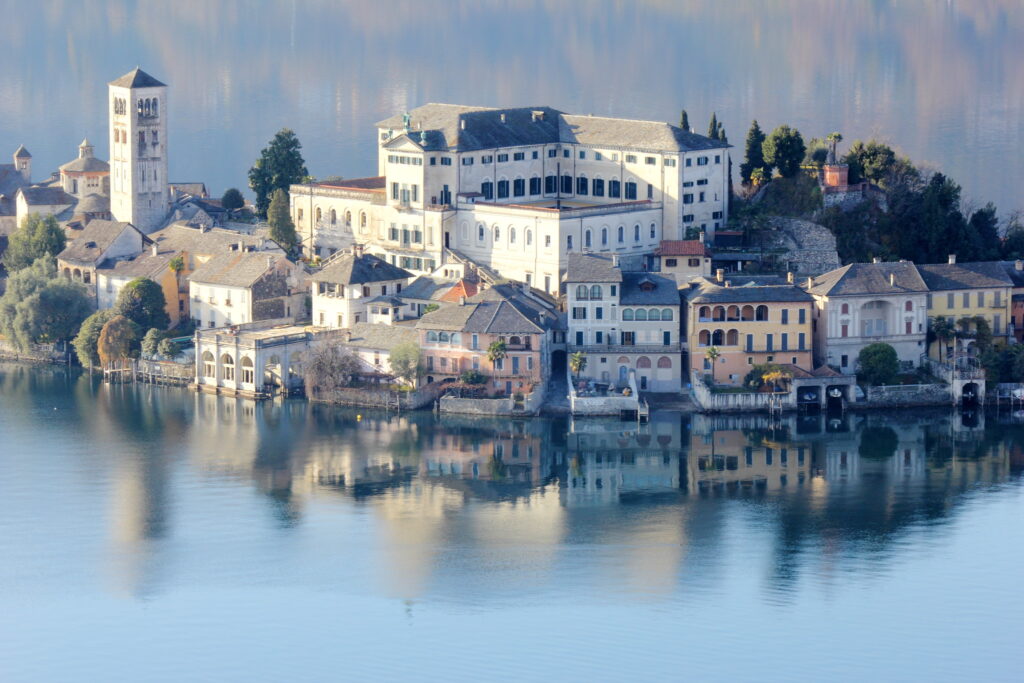
The inlet of San Giulio (Photo: Jorge Cancela via Flickr / CC BY 2.0)
Bellagio, Lombardy
Bellagio sits at the conjunction of the two lower branches of Lake Como. Such a prime location has earned it VIP status since Roman times, evidenced by its lush collection of villas and lakeside gardens. The cobbled steps of Salita Serbelloni cut down the main hamlet, a collection of paved streets and elegant porticoes populated by artisan shops and fashionable boutiques. The Pescallo district takes visitors away from the crowds and into a former fishing hub, while San Giovanni is home to intriguing attractions such as the ‘House of Flying Bicycles’. The hillside hamlets have some of the best views of Lake Como.
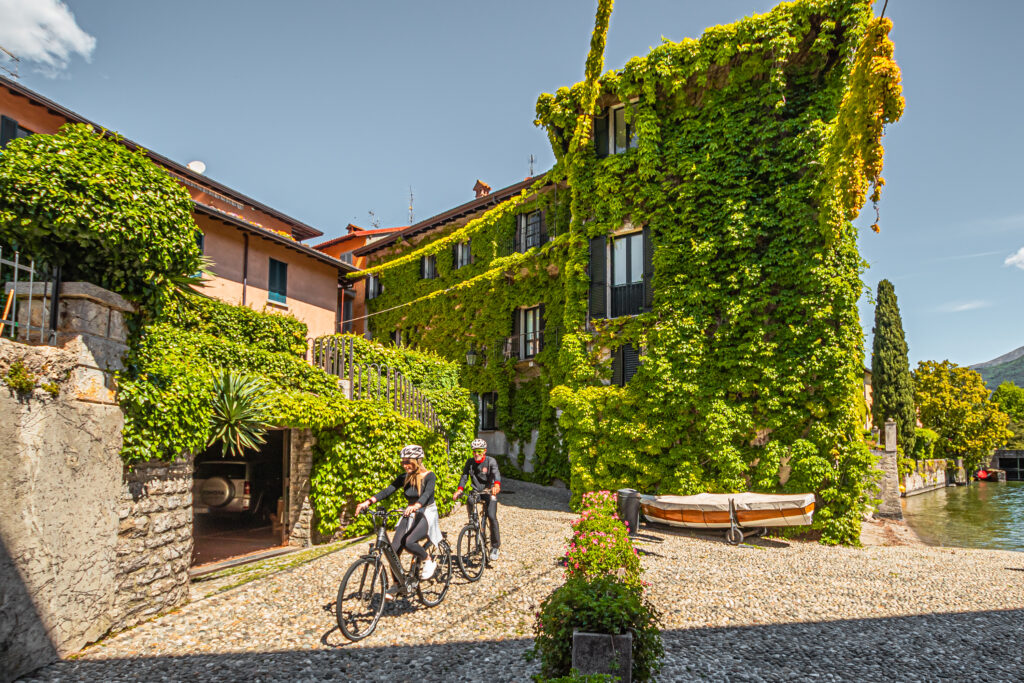
The fishing hamlet of Pescallo (Photo: courtesy of Promobellagio)
Grado, Friuli-Venezia Giulia
Formed of 30 islands, this lagoon town bears echoes of nearby Venice, which it predated as a rising power in the upper Adriatic Sea. It subsequently became a more marginal fishing hub, but reminders of its heyday live on in early-Medieval architecture such as the neighbouring basilicas of Sant’Eufemia and Santa Maria delle Grazie. Outside the old town, Liberty-style architecture and 19th-century coastal promenades add a romantic note, while wide beaches and modern summer facilities cater to youngsters and families alike. The accommodation options include traditional thatched fishermen’s houses (casoni) scattered across the inlets of the lagoon.
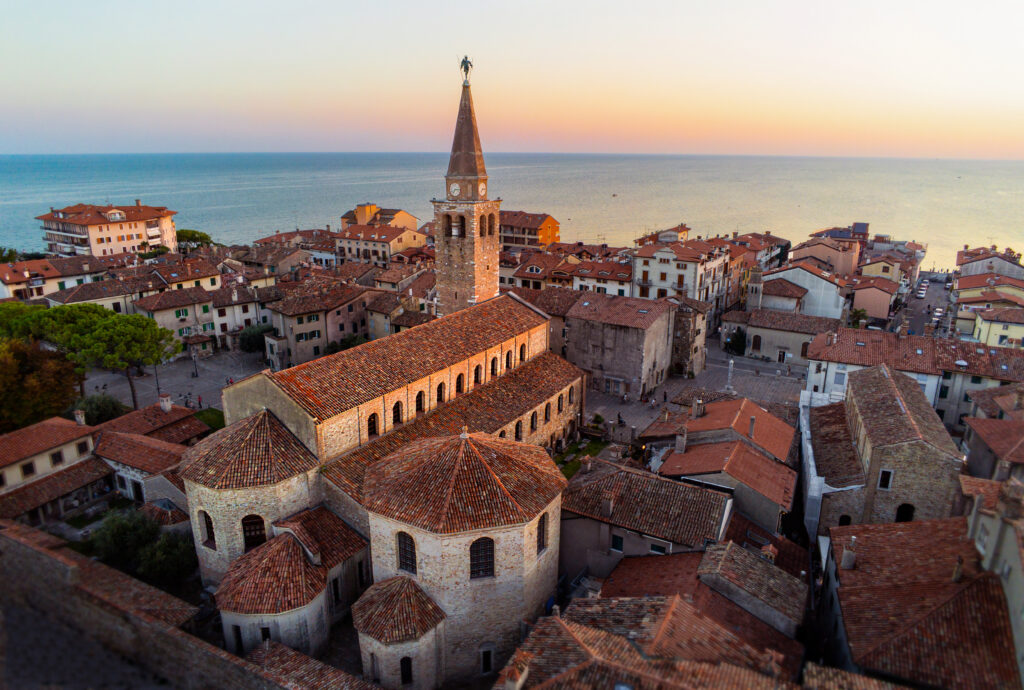
Grado at sunset (Photo: Ivan Regolin, courtesy of Consorzio Grado Turismo)
Malcesine, Veneto
Wrapped around a picturesque harbour, Malcesine lies on the Veneto shore of Lake Garda. An early-Medieval castle dominates the town from atop a spur of rock, its pentagonal tower soaring 70 metres above the water. Now a museum, the castle features charming views and sketches taken by Johann Wolfgang Goethe (who was mistaken for an Austrian spy and briefly detained when caught drawing). The Palazzo dei Capitani houses a panoramic garden, while the 2,218-metre cable car to Monte Baldo provides a change of scenery from the town’s cobbled lanes and lakeside cafes. Several shingle beaches stretch along the surrounding shoreline.
Camogli, Liguria
Looking out to Paradise Gulf, the multicoloured waterfront of Camogli exudes Ligurian charm. The Medieval castle stands beside the harbour, where bobbing fishing boats echo the local nickname – ‘the thousand-vessel town’. Fish cuisine is another trademark, best enjoyed alongside regional classics such as trofie al pesto, pansotti with walnut sauce, and cheese focaccia (originally from neighbouring Recco). One of Italy’s best food festivals takes place every year in May, involving thousands of visitors and tons of bluefish fried in a giant pan. Summer weekends are also very busy, especially on the main shingle beach flanked by Mount Portofino.
Cervo, Liguria
Surrounded by hills overlooking the Ponentine Riviera, Cervo is a typical Ligurian town where multicoloured houses slope towards the sea. Unlike many of its regional neighbours, however, it has managed to stay off the mass tourism radar. As part of a well-preserved Medieval layout, the Oratory of Saint Catherine features a Gothic gate mounted on a Romanic facade, while the Clavesana Castle hosts an ethnographic museum. There’s no lack of beaches and summertime facilities, but a year-round programme of events reflects the town’s commitment towards sustainable, community-minded tourism. An international chamber music festival takes place every year in July and August.
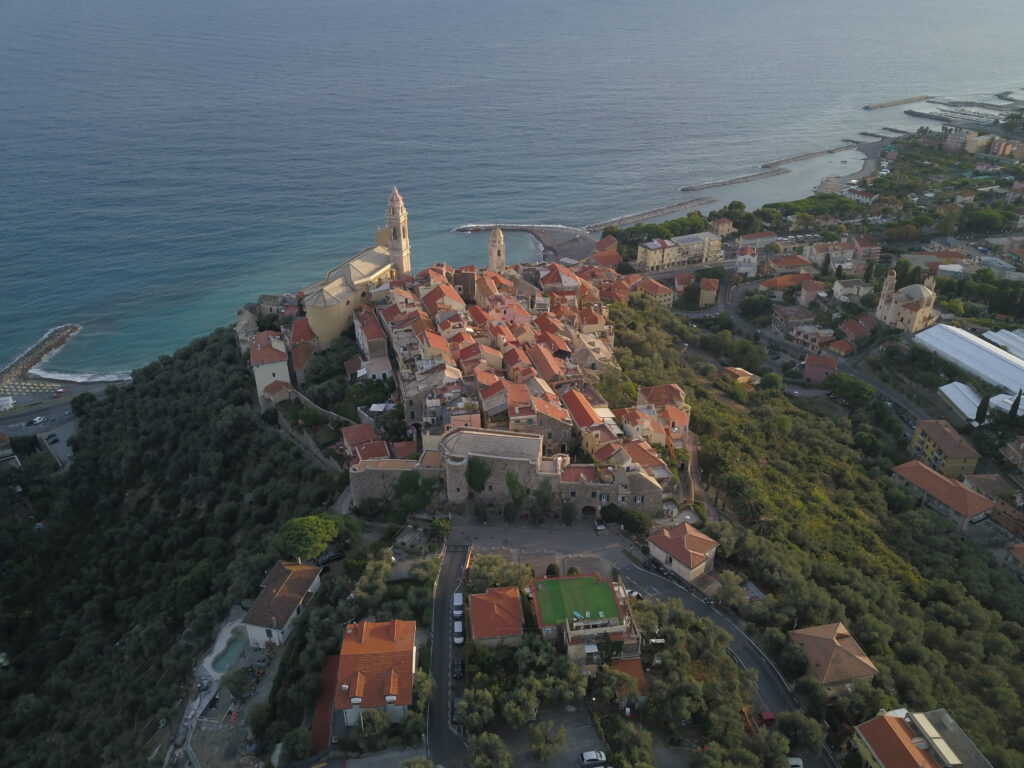
Bird’s eye over Cervo (Photo: courtesy of Comune di Cervo)
Portovenere, Liguria
Tightly packed tower houses cling to the rock that lines the harbour of Portovenere. The fortress above them testifies to the town’s historical affiliation to the old Republic of Genoa, as does St Peter’s Church, which stands solitary at the tip of the promontory. In between them, Byron’s Grotto recalls the legend of Romantic poet Lord Byron’s solo swim across the gulf to meet his friend Percy Shelley. Even if for less heroic dips and sunbathing, the choice of beaches is wide and varied, including those located on the opposite Palmaria Island. High-season crowds might pour in from neighbouring Cinque Terre.
Cesenatico, Emilia Romagna
The vast beaches and shallow water of the Riviera Romagnola lend themselves to summer parties and leisure, to which Cesenatico adds a rich cultural offering. The centuries-old canal port is its main feature. Leonardo Da Vinci visited it in 1502, and the drawings he took possibly inspired the latest iteration. Historic boats float along the canal with their colourful sails, forming part of the must-see maritime museum. More of the local traditions can be explored during the occasional reenactment of ‘tratta’ fishing, or by delving into the bluefish-centric cuisine. Culinary festivals take place in spring and summer, while genuine local restaurants are available all year long.
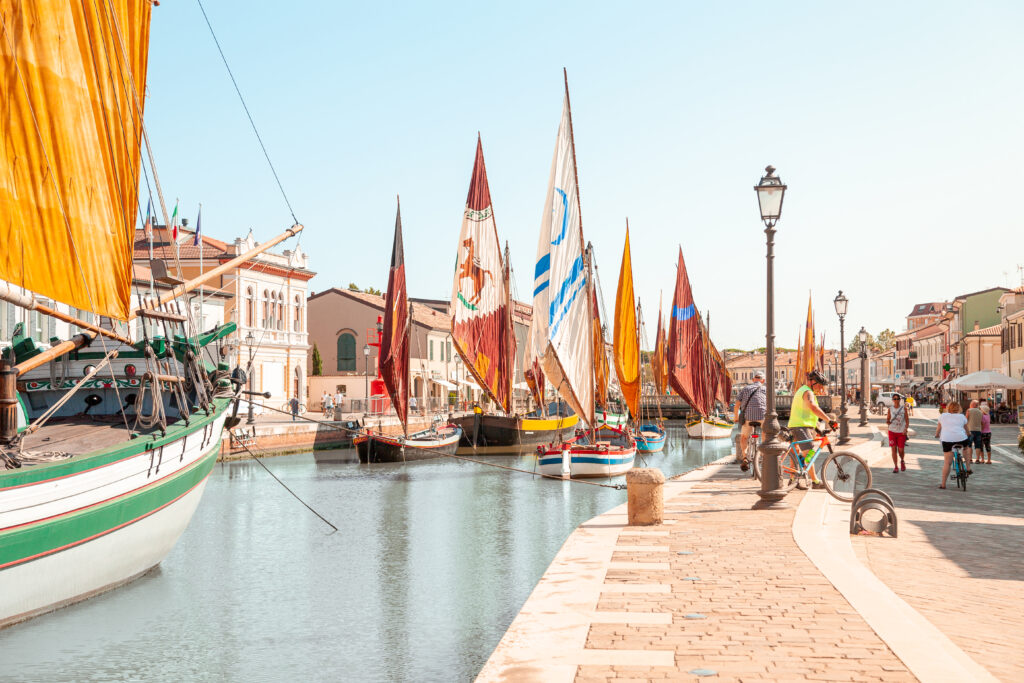
Historic boats on the canal port of Cesenatico (Photo: courtesy of Ufficio Turismo Cesenatico)
Castiglione della Pescaia, Tuscany
Leaning on the hillside, the old town of Castiglione della Pescaia is encircled by Medieval walls punctuated with ancient gates. The alleys winding uphill lend themselves to spontaneous explorations among the stone houses and historic palaces. At the top, the 10th-century castle, which was once a Pisan watchtower, looks out over the Tyrrhenian Sea and the Tuscan Maremma. The modern town stretches along the coast providing tranquil settings and a variety of beaches, cut through by the canal port. This leads inland to the Red House Ximenez, home to a multimedia museum about the reclamation of the marshland.
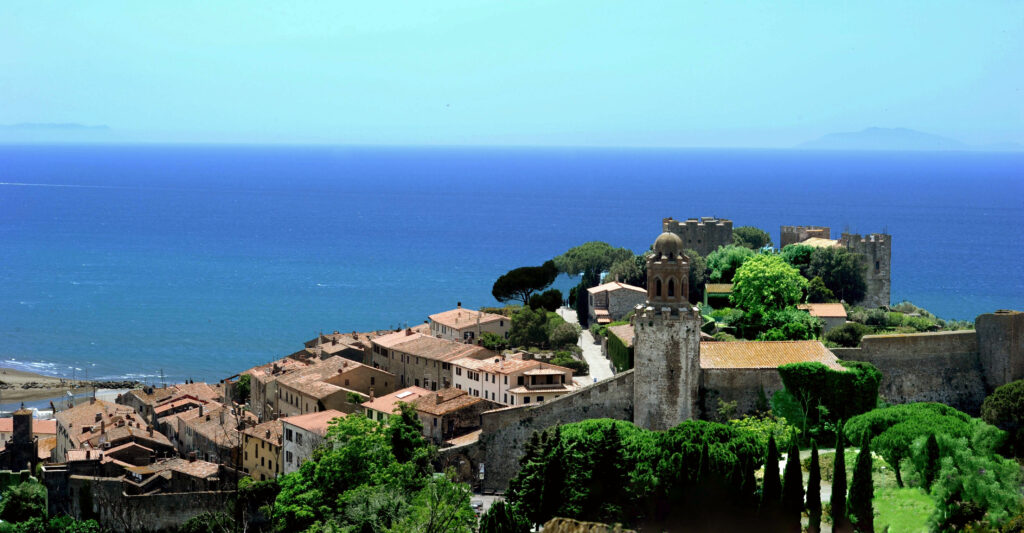
The castle atop Castiglione della Pescaia (Photo: courtesy of Comune di Castiglione della Pescaia)
Porto Santo Stefano, Tuscany
The Southern Tuscan peninsula of Monte Argentario is widely praised for its natural treasures, which offer a backdrop to its main town Porto Santo Stefano. Most ancient features were lost to Allied bombings during WW2 and quickly replaced with pretty lanes and postwar architecture. The winding promenade is a delight in the summertime, lined with cafes and restaurants as it passes by two harbours. The 16th-century Spanish Fortress claims the best views in town, and its halls display permanent maritime exhibitions. Pebbled, rocky and sandy stretches of coast leave nothing to be desired in the way of clear water and scenic beaches.
Sirolo, Marche
Immersed in the Conero natural park, the cliff-side town of Sirolo sits over 100 meters above sea level. Its panoramic quality is epitomised by the piazzetta, where gelato and aperitivos come with sweeping Adriatic views. Down at sea level, cobalt-blue water meets characteristic white rocks and wide sandy stretches. The beaches of San Michele, Urbani and Due Sorelle are some of the closest options, but many others can be discovered by venturing further along the wild coast. Portions of city walls, ancient towers and evocative alleys sketch a vivid picture of the town that once developed around the castle.
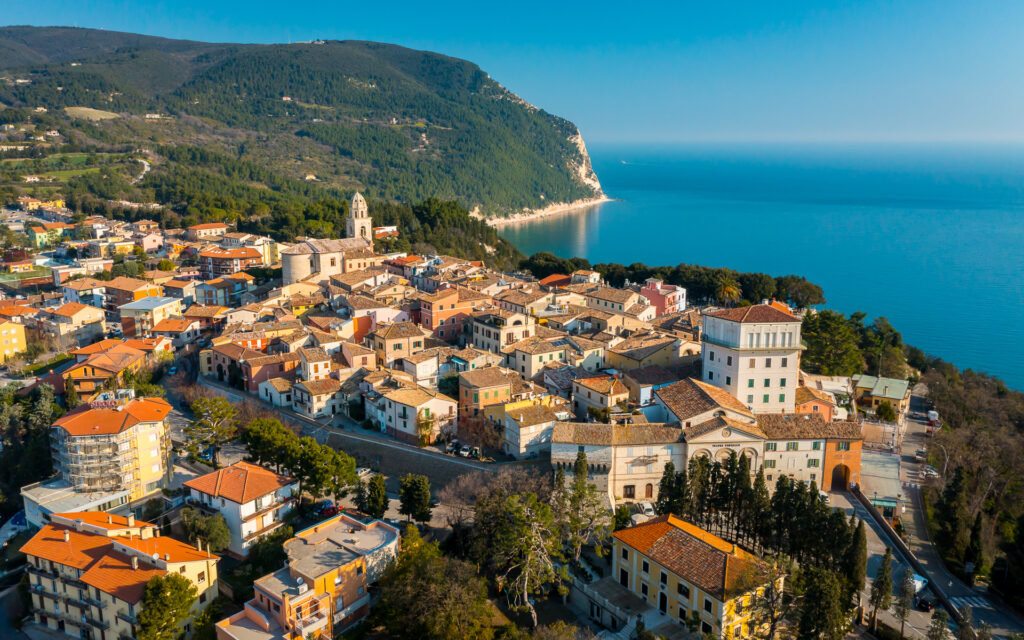
Sirolo looking out to the Adriatic Coast (Photo: Studio 8Zero, courtesy of Turismo Sirolo)
Castiglione del Lago, Umbria
Located on the Western shore of Lake Trasimeno, Castiglione del Lago is defined by its Renaissance palace and Medieval castle. The latter gives its name to the town, appearing as a pentagonal-plan fortress topped by a distinctive tower. Open to visitors, the scenic walkways along the ramparts look out to the lake, connecting the castle and Palazzo della Corgna. This is among the region’s most striking landmarks, where art exhibitions sit alongside awe-inspiring frescoes depicting historical battles and mythological scenes. Outside the old town, relaxing landscapes and lakeside facilities can be found along the shore.
Anguillara Sabazia, Lazio
Anguillara Sabazia lies on a small promontory jutting into Lake Bracciano, only 30km north of Rome. Traditionally a popular weekend gateway from the Eternal City, this quiet destination is gaining acclaim thanks to its shoreline facilities and famously clear water. Understated charm runs through the small streets of the old town, where Medieval remnants are blended into a 15th-century urban layout. The main church looks out to the lake from atop the hill, although the best belvedere is offered by the Eels Fountain. A Medieval tower houses the local folk museum (Museo storico della civiltà contadina e della cultura popolare ‘Augusto Montori’).
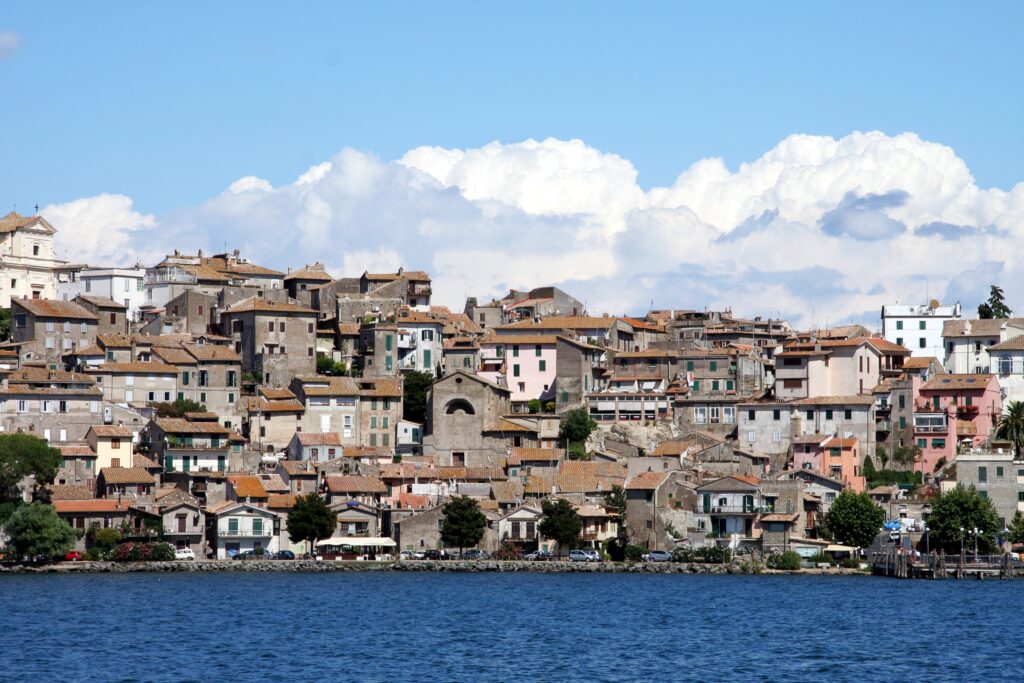
Front view of Anguillara Sabazia (Photo: AngMoKio via Wikimedia / CC BY SA 2.5)
Sperlonga, Lazio
Sperlonga owes its name to the many grottos piercing the coastline of southern Lazio (speluncae). The most famous of them formed part of a Roman Villa that belonged to Emperor Tiberius in the 1st century CE and was adorned with splendid Odyssey-themed sculptures, now displayed at the archaeological museum. Aside from ancient treasures, the whitewashed houses of the old town sit like a crown atop the rocks, fronted by the 16th-century Torre Truglia watchtower. Wide sandy beaches and excellent water mean the 3000 residents double up during the summer, while two lakes provide an alternative to the seaside setting.
San Vito Chietino, Abruzzo
Stretched atop a rocky spur, San Vito Chietino overlooks the Costa dei Trabocchi, named after the traditional fishing structures punctuating the shoreline. These now-dismissed contraptions include the Trabocco Turchino, which gives a distinctive touch to the adjoining beach. Other beaches are set against scenographic sandstone cliffs, providing complete relaxation in a secluded setting. Many belvederes are scattered around the town, offering views ranging from the Maiella massif to the Tremiti Islands. The San Vito-style fish broth is a standout of the local cuisine, alongside regional Abruzzo specialities such as arrosticini (small sheep skewers).
Bosa, Sardinia
Bosa boasts one of Italy’s most colourful townscapes, with hundreds of candy-coloured houses stacked on a steep hill topped with an impressive castle. The River Temo – Sardinia’s only navigable river – splices through the heart of the town and boat trips run regularly from the marina. There’s a cluster of sights and handsome churches in the centre of town, like the Rococo-style Cathedral of Bosa, though many head straight for the beach and its limpid turquoise waters, for which Sardinia is famous. Not far from the beach the Cane Malu, a natural pool carved in white trachyte rock, is a popular diving spot.
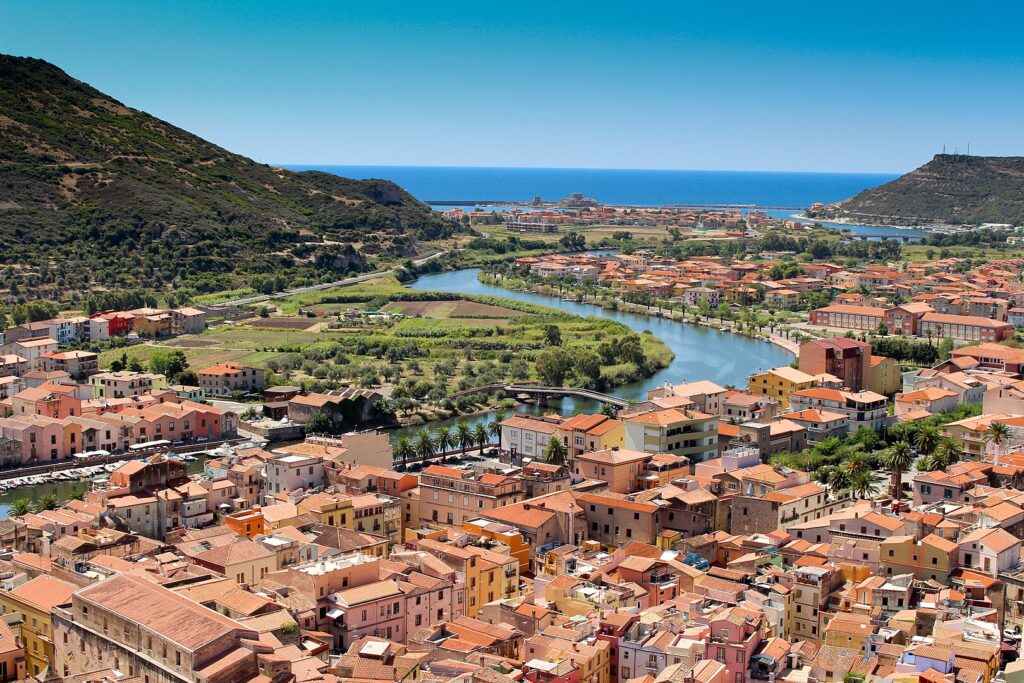
The rooftops of Bosa (Photo: Zsuzsanna Tóth via Wikimedia / CC0)
Carloforte, Sardinia
Those wishing to eschew the glamour and high prices of Costa Smeralda should hotfoot to Carloforte. Floating four miles off the southwestern coast of Sardinia on the tiny island of Isola di San Pietro, this bustling port town is known to few outsiders. In the old town, visitors can sample speciality tuna caught with traditional methods or indulge in a late-night snack of farinata, a Genoese chickpea flatbread served up and down the tiny lanes that make up the Old Town. For beach lovers, a string of miniature beaches carved out of pink volcanic rock, rock pools and a handful of secret coves await.
Castelsardo, Sardinia
Perched on a volcanic headland on Sardinia’s northern coast, Castelsardo is a town with two distinctive identities. The Medieval Quarter is a colourful maze of sloping lanes and alleys that cascade beneath the immense Castello dei Doria and its ramparts, which now houses the Museo dell’Intreccio del Mediterraneo. In the evening, cafes set up tables that spill out down the streets and offer sweeping views over the beaches, bays and a run of pretty coves. The neatly packed ‘new’ town sits further down the hill and leads to a handful of hotels by the sea and a small sandy beach.
Termoli, Molise
Timeless Termoli is one of the largest towns in Molise, a region jokingly ‘forgotten’ by even the Italians. Most people flock here for its shallow and sandy beaches, said to be among the most beautiful in the region, though there’s much more to the town than sand and sea. The walled Old Town is a maze of pastel-painted narrow streets which sit on a promontory along with the ancient Svevo Castle and elegant Romanesque Cathedral that survived the sacking by the Ottomans. The pedestrianized Corso Nazionale in the ‘new’ town is crammed full of shops, al fresco restaurants and street sculptures. It’s also home to A Rejecelle, Italy’s narrowest street.

View of Termoli (Photo: Luca Aless via Wikimedia / CC BY-SA 4.0)
Cetara, Campania
Those who adore the Amalfi but abhor the crowds should look to Cetara, a tiny and oft-overlooked town at the end of the Amalfi coast. What it lacks in cascading terraces and postcard-perfect pergolas it more than makes up for in authentic charm. Famed for its anchovies, no trip to the town would be complete without sampling colatura di alici, an anchovy paste used in fresh pasta and pizza dishes. The beach is small and perfectly formed, a short stroll from the town centre, which is brimming with brilliant eateries, boutiques and bobbing fishing boats.
Positano, Campania
The Amalfi Coast’s crowning jewel hardly needs an introduction, so famous are its stacked pastel-hued houses, tiny crescent bay and winding cobbled alleys flanked with lemon trees and wisteria. It’s long been a destination du jour for the rich and famous, but it remains no less enchanting today. The town’s two beaches are both lined with summer beach bars and boutiques offering ceramics and colourful clothes, though many of the best restaurants are located in the heart of town. Beyond the beaches, the Chiesa di Santa Maria Assunta, with its brightly tiled cupola, is well worth a visit.
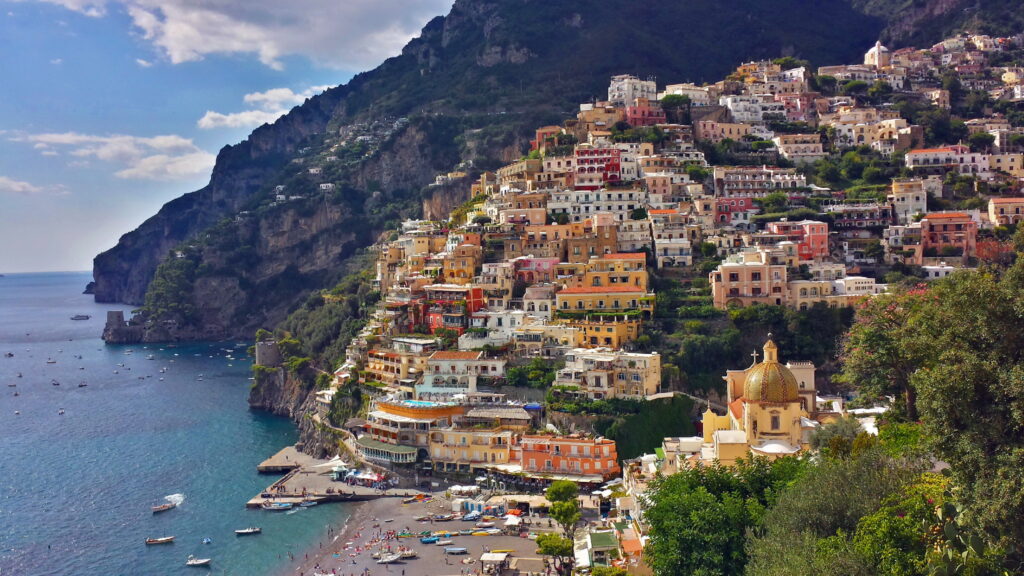
The iconic view of Positano (Photo: pululante via FLickr / CC BY 2.0)
Ravello, Campania
Historically overlooked by its flashier cousins Positano and Capri, Ravello is blessed with fantastic food, history and places to visit, as well as several superb sandy beaches. But while the town may be more laid-back than most, it’s undeniably glamorous; legend has it DH Lawrence penned chapters of Lady Chatterley’s Lover in town and everyone from Greta Garbo to Leonardo di Caprio has holidayed here. Little wonder why. The traffic-free lanes are lined with coloured stucco houses, refined restaurants and there’s no shortage of shops selling limoncello and local delicacies. The historic Villa Cimbrone boasts heart-stopping views of the Neapolitan Riviera too.
Otranto, Puglia
Most of Puglia’s eastern coast meets the sea as volcanic rock, but deep in Italy’s stiletto, powder-blue sea laps endless stretches of cream-coloured sand. The fortress-like town of Otranto is the easternmost town in Italy and has always been susceptible to attacks from across the Adriatic. The Greeks, Romans, Turkish and Napoleonic all rampaged through and left their mark, resulting in a charming melange of architectural styles and sights, from the 15th-century castle to a magnificent cathedral covered in 12th-century mosaics. The seafront promenade, which is lined with laid-back seafood restaurants and bars, leads to a thronging yet charming white sandy beach.
Polignano a Mare, Puglia
Precariously positioned on the edge of a 20-metre-high limestone cliff undercut by dozens of caves, this gleaming white-washed town was once one of Puglia’s most important ancient settlements. Today, it’s best known for its gelato, postcard-pretty beach and Domenico Modugno, who wrote the hit-song Volare. The Old Town is a labyrinth of lanes bookended by a medieval gate and peppered with picturesque churches, piazzas and artisanal shops. Come summer, you’ll regularly catch locals hurling themselves off the cliffs into the crystal-clear waters of the Adriatic Sea before stretching out in the sun on the Blue Flag beach, flanked by the cliffs.
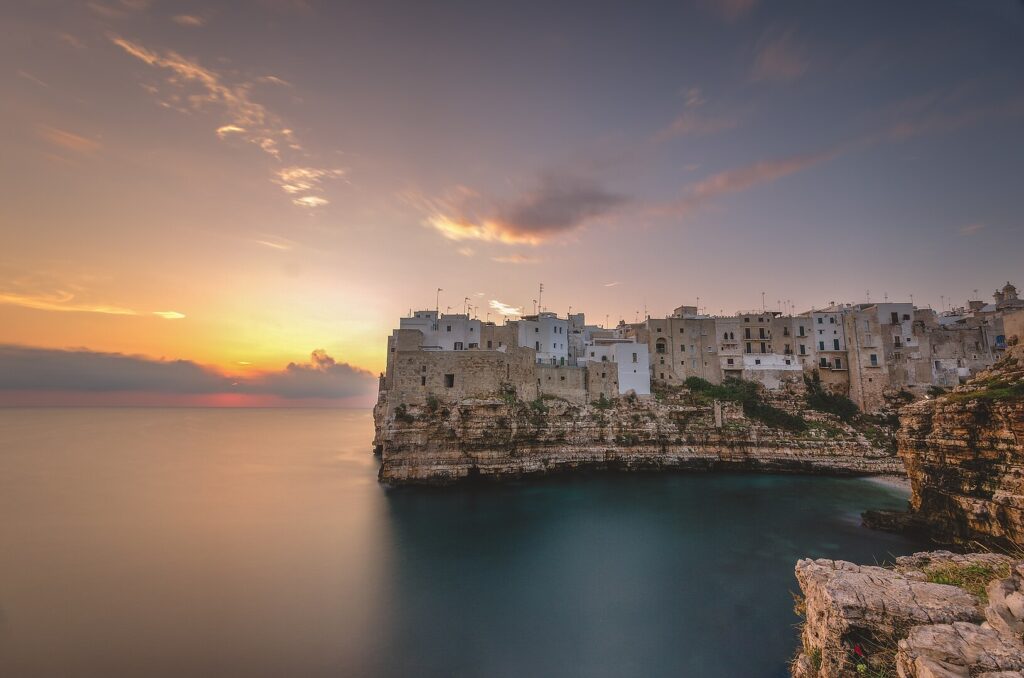
Sunrise at Polignano a Mare (Photo: Domenico Lacava via Wikimedia / CC BY-SA 4.0)
Vieste, Puglia
Vieste is the largest town in the Gargano, an enclave of forest and cliff-edged coastline right at the tip of a spur in Italy’s sun-bleached heel. Its whitewashed houses hug the cliffs, squeezed between silvery-grey olive and almond trees and the cobalt-blue Adriatic Sea, which makes for some exceptional views. Down below, two sweeping yellow-sand beach stretch across the bay. Beyond sunbathing, the Old Town is crammed full of interesting sights, including an ancient monastery, a Baroque cathedral and trabucci – ancient fish traps used to catch mullet – while the Parco Nazionale del Gargano offers acres of exceptional hiking terrain.
Maratea, Basilicata
This 20-mile strip of Tyrrhenian coast is endowed with dozens of sandy beaches and 50 or so grottoes, accessible only by boat. High above, atop the 624-metre Monte San Biagio, Maratea’s Christ the Redeemer looms over a collection of churches, which explains why the town is fondly nicknamed “the little town of 44 churches”. The stylish harbour is the social centre of the town, peppered with lively restaurants, cafes and bars, as well as a handful of glitzy super yachts, but you’ll find far fewer selfie sticks here than in most Italian beach towns.
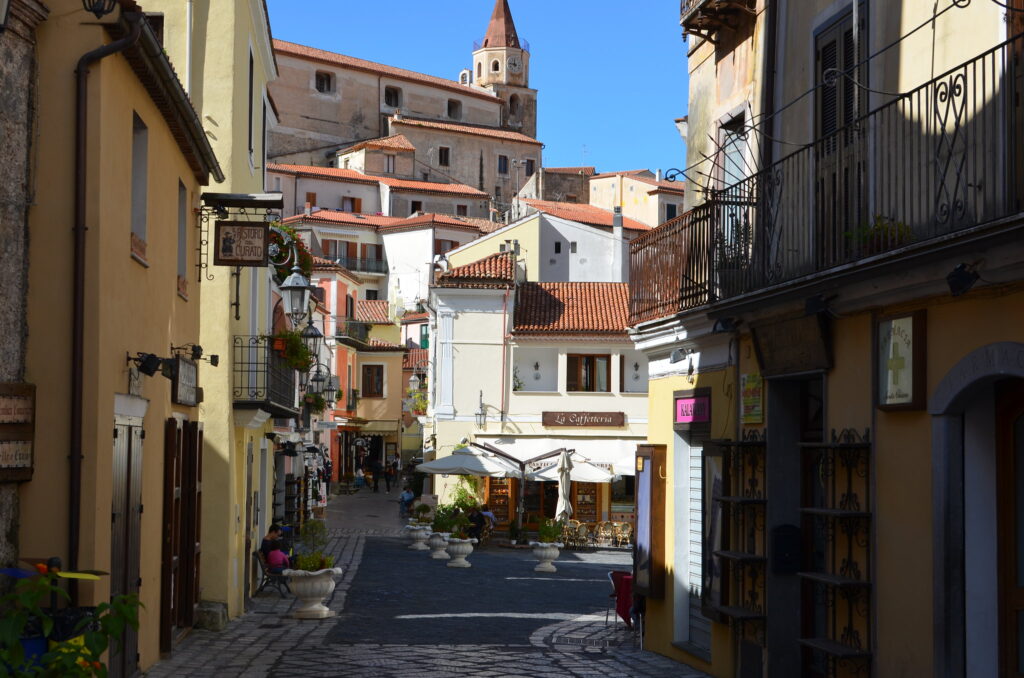
The centre of Maratea (Photo: Alexander Van Loon via Flickr / CC BY-SA 2.0)
Scilla, Calabria
Named after the water nymph who transformed into a six-headed sea monster and put an end to six of Odysseus’s crew, Scilla enjoys a slower pace these days. It’s situated an hour and a half south of Tropea, on a less venerated stretch of Italian shoreline, which makes a pleasant respite from the crowds of Campania. It’s a ludicrously pretty town, with sherbert-coloured buildings tumbling down the hills, wide sandy beaches and a handful of excellent trattorias, bodegas and markets selling freshly caught swordfish. The imposing Castello Ruffo stands at the end of the promontory and offers panoramic views of the coastline.
Tropea, Calabria
Legend tells that Hercules founded Tropea, though in truth it has been occupied since Neolithic times. Today, it’s as famous for its cliff-hanging setting as it is for its sweet, red onions. Come summer, the town comes alive as families flock to the powder-white beaches and caves which sit under the medieval monastery of Santa Maria dell’Isola, an iconic emblem of Calabria. The town is a small cluster of white buildings, enchanting alleys and bustling piazzas primed for people-watching. It boasts some of the most spectacular sunsets in the south too.
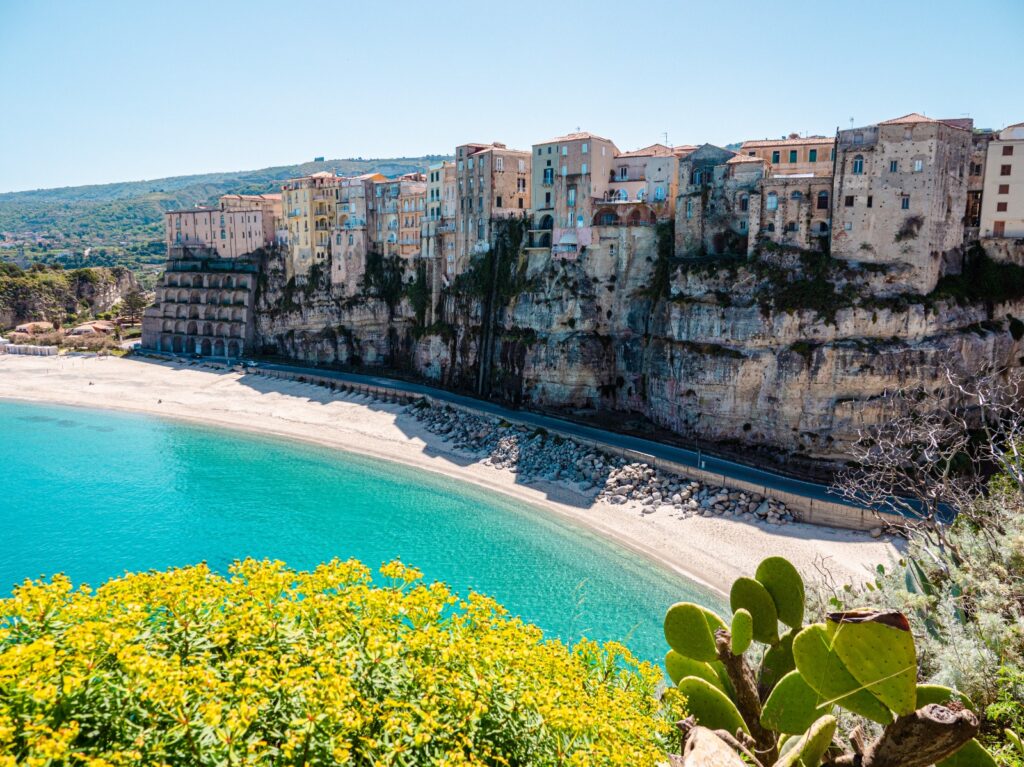
Dramatic cliffs and turquoise water in Tropea (Photo: courtesy of Proloco Tropea)
Castellamare del Golfo, Sicily
Located on the north-western coast of Sicily between Palermo and Trapani, Castellamare del Golfo is a real hidden gem. Pastel-painted houses tumble down into the handsome, curved harbour, which is lined with restaurants serving freshly caught seafood and a smattering of working fishing boats. The sea is the main attraction here and there are two beaches for visitors to choose from: La Plaja and Cala Petrolo. At the far edge of the latter, an ancient flight of steps leads to the oldest part of town – a defensible citadel which is now home to the Ethno-Anthropological Museum.
Taormina, Sicily
Taormina sits on a rocky promontory facing the Ionian Sea. Renowned for its perfectly-preserved medieval streets, jewel-box churches and dramatic views of Mount Etna, the town became an integral stop on the 18th-century Grand Tour and never lost its glamorous reputation. Today, thousands of visitors flock here in the summertime for its grand hotels, chi-chi shops and blockbuster sights, including a spectacular 13th-century cathedral, horseshoe-shaped Greek-Roman theatre and pedestrian-friendly roads lined with Arab, Norman and Gothic architecture. From May, striped sun loungers line its pretty pebbly beaches of Mazzaro, Isola Bella and Spisone.